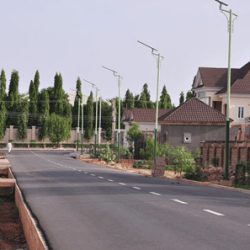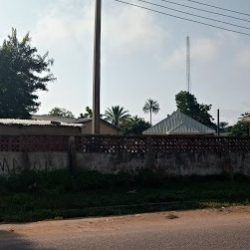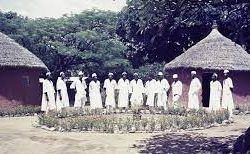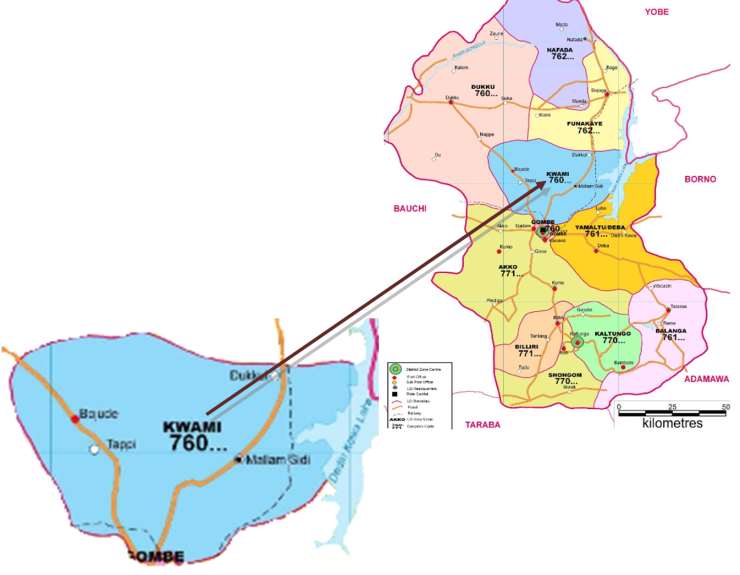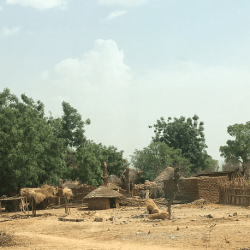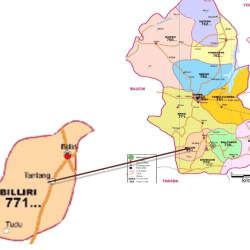Akko local government area is one of eleven local government areas in Gombe state which is located in the Northeast geopolitical zone of Nigeria.
With its headquarters in the town of Kumo, the Akko LGA consists of towns and villages which include Garin Garba, Kembu, Dongol, Kombani, Pindiga, Gokoru, and Wuru Siddiki.
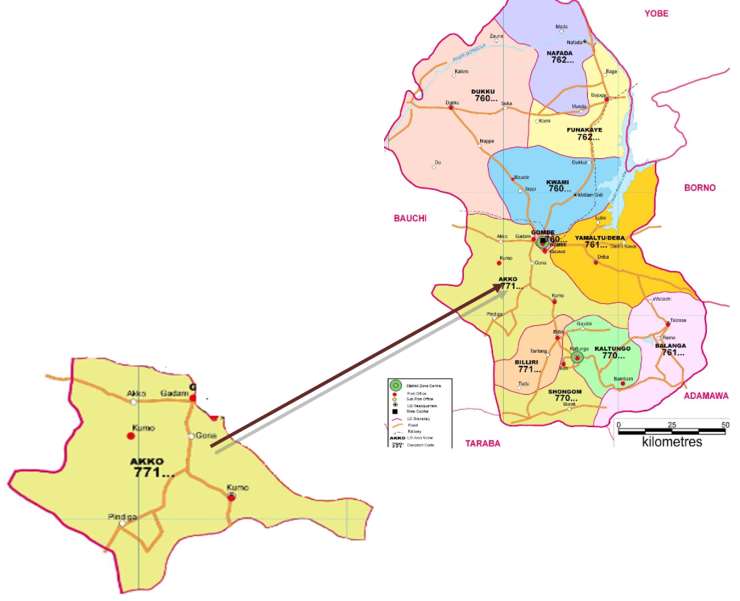
The major tribes in Akko LGA are the Hausa and the Fulani with the Hausa and the fufulde languages spoken widely in the area.
Festivals celebrated in Akko LGA are Eku and Tangra festivals among others while popular landmarks within the area include Pindiga hills.
| Communities | Amada-Akko Dundado Gamawa Gona Kashere Kembu Kidda Kumo Lafiya-Mango Shongo-Hamma Tumpure Wuro-Yayangari |
| Headquarters | Akko |
| GPS Coordinates | N10017’21.6″E010058’12.5″ |
| Post Code | 771002 |
| Area | 2,627 km² |
| Tribes | Hausa Fulani Tangale Kanuri |
| Major Crops Produced | Maize Beans Millet |
| Major Livestock Produced | Cattles Ruminants Poultry |
| Major Attractions | Annual Sallah Durbar |
| Other Attractions | Chroma Forest, Bobo Wrestling, Kembu Stream, Kumo Dam, Layinot Forest, Binga Hills, Akko Dam, Kala Gambo Hills, Pindiga Jukun Old Settlements |
| Core Mineral | Silica Sand |
| Comparative advantage products | ⋅ Limestone⋅ Halite ⋅ Maize ⋅ Millet ⋅ Bentonite ⋅ Cane Sugar ⋅ Cowpea ⋅ Graphite ⋅ Groundnut ⋅ Gum Arabic ⋅ Livestock ⋅ Poultry ⋅ Silica Sand ⋅ Tomatoes ⋅ Uranium Potassium Kaolin Coal Crude Petroleum Lead Ventiline. |
Distance of Akko communities, Akko LGA headquarters and Gombe town, the state capital
| Community | Distance from LGA Headquarters | Distance from State Headquarters |
| Amada-Akko | 48.14KM | 20.50km |
| Dundado | 27.98KM | 12.63km |
| Gamawa | 9.39KM | 17.60km |
| Gona | 25.67KM | 11.12km |
| Kashere | 43.85KM | 45.81km |
| Kembu | 29.91KM | 29.91km |
| Kidda | 33.59KM | 33.59km |
| Kumo | 0.KM | 28.03km |
| Lafiya-Mango | 34.91KM | 8.31km |
| Shango | 33.58KM | 6.95km |
| Shongo-Hamma | 32.42KM | 4.95km |
| Tumpure | 33.2KM | 5.72km |
| Wuro-Yayangari | 7.99KM | 19.14km |
GEOGRAPHY
Akko local government area covers a total 2627 km square and has an estimated humidity of 39 percent while wind speed of the area is pegged at 8km/h. The average temperature of Akko LGA is estimated at 30 degrees centigrade while the dry and the rainy seasons are the two main seasons in the area.
ECONOMY
Agriculture and commerce are key features of the economic life of Akko LGA with markets such as the Tike, Babbar Kusawa, and the Tashar Gwari markets attracting thousands of buyers and sellers to the area.
Gombe
Gombe is one of the 36 states of Nigeria. It is located in the north eastern part of the country.
The state was created out of Bauchi state on 1st October 1996 by Sani Abacha’s administration.


Its creation was a fulfilment of the aspiration of the people who for long, had passionately craved for a state of their own out of the then Bauchi state.







Gombe State has eleven Local Government Areas (LGA) namely, Akko, Balanga, Billiri, Dukku, Funakaye, Gombe, Kaltungo, Kwami, Nafada, Shongom, and Yamaltu Deba.
The following are administrative maps of Gombe State showing the local government areas

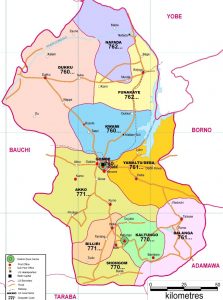
Historically, Gombe state is a fusion of two distinct groups of people, comprising the people of Gombe North and the ethnic grouping of Gombe South.
Gombe is located on latitude 9”30’ and 12”30’N, Longitude 8”5’and 11”45’E.
It has borders with Borno, Yobe, Adamawa, Taraba, and Bauchi states.
The State climate is generally warm, with temperatures not exceeding 300c during the months of March-May considered to be the hottest months. The following table gives other profile of the jewel state.
The following Map indicates in red the position of Gombe in relation to the thirty six (36) states of the federation.
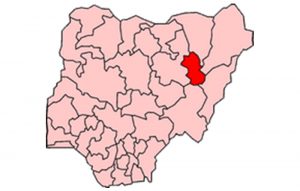
The Emirate government, which had its Head quarters in Gombe Abba, was formed to effectively control what constitutes a larger part of the Gombe State, until the advent of the British in the early 20th century.
Under the British, the state was administered through the mechanism of two administrative units, i.e. Gombe Native Authority and Tangale Waja Native Authorities. The two Authorities constituted Gombe Division during the Colonial era. However, with independence in 1960 and the subsequent military administration, many changes occurred which led to the emergence of local government authorities. Thus, between 1976 and the present, the then two authorities had metamorphosed into the present 11 local governments.
Capital: Gombe
Land area: The State occupies a total land area of about 20,265sqkm.
Climate: Warm, exceeding 40″c during the hottest month (March – May)
Topography: Mainly mountainous, undulating and Hilly to the South-East and flat open plains in the Central, North, North-East, West and North-West.
Location: Latitude 9”30’ and 12”30’N, Longitude 8”5’and 11”45’E. The state lies in the centre of North east Geopolitical Zone of Nigeria. It shares common boundaries with Adamawa and Taraba State to the South, Bauchi State to the West, Borno State to the East and Yobe State to the North.

Power: The State is served by the PHCN National grid through the North-East PHCN substation located in Gombe State capital
Roads: Five(5) Federal trunk “A” roads connect the State Capital with all parts of the Country. Twonship roads have been constructed in the State capital and all the major towns.
Airport: The State has an International Airport which is also surrounded by four (4) International Airport, located in Kano, Jos, Yola and Maiduguri.
Major towns :Gombe the capital, Bajoga, Billiri, Kaltungo, Kumo, Dukku and Deba.
Ethnic CompositionMulti-ethnic, mainly made up of Fulani, Tangale, Waja, Bolawa, Tera,Jukun, Jara, Pero, Tula, Cham, Lunguda, Dadiya, Kamo, Awak, Kanuri, Hausa, Yoruba and Igbo.
Language spoken: English is the official language, but as much as Hausa remain the commercial language amongst the people of the state, Fulfulde, Tangale, Tera, Waja, and Kanuri are commonly spoken.
Vegetation: Gombe is generally a Guinea Savannah grassland with concentration of wood lands in the South East and South West.
Rainfall: Annual Average of 850mm.

